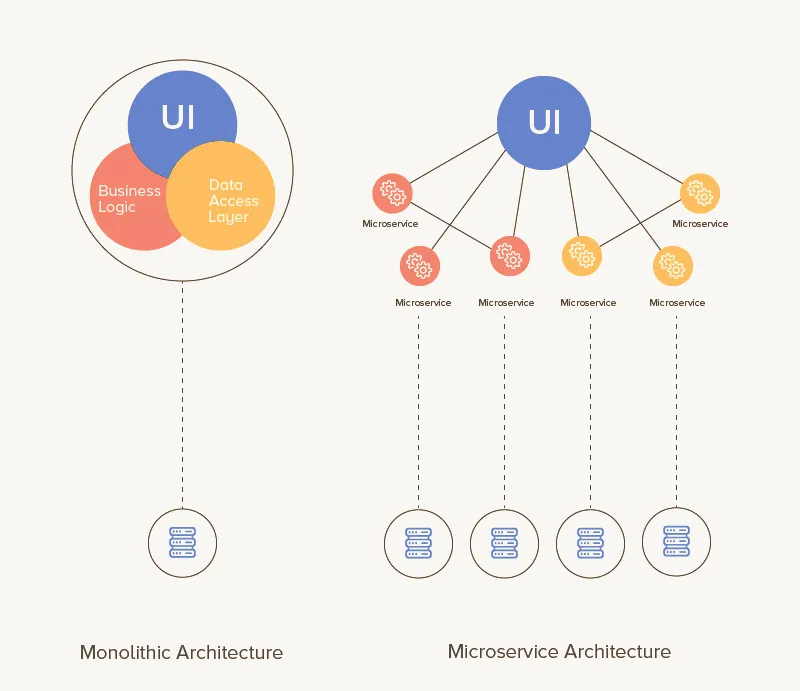Do's and Must Do's - 10 Microservices Architecture Best Practices

Monolithic systems are difficult to maintain, says every entrepreneur out there. The digital unicorns spare no time staying untangling the mess associated with their business. With the increasing complexities pertaining to the growing data, a smarter decision seems like using microservice architecture.
With the creation of a flexible, reliable, and scalable enterprise architecture, the transition from a monolithic to a microservice architecture is made in a revolutionary way. Although the term “microservices architecture” is generally recognized by its name, many businesses that steadfastly use monolithic architecture struggle with the decision of whether or not to adopt it.
So to detangle the confusion for once and for all, I present a blog with a thorough understanding of microservices architecture best practices.
Is microservices architecture the right solution for your business?
Is it a Safe Bet to Move to Microservices Architecture from Monolithic Architecture?

Now that’s the question at the top of your mind that we are going to answer.
Microservices architecture can be considered like your furniture at your office. Without furniture, you might find it difficult to organize the things in your office. Similarly, when it comes to a mobile app or a web app, it is crucial for you to have a system. Wherein:
- You can easily test as well as maintain your mobile app and web app.
- You can be self-sufficient in the deployment.
- Formulate alongside organizing your business abilities.
- A relatively smaller team can handle your app.
When such criteria are met, it means that your mobile app or web app is not microservices-architecture compatible. Using the microservices architecture best practices, you can develop release new features and modules at the speed you want and gauge them based on your benchmark.
In addition to this, you do not have to put your entire team working on a single module and take up your resources. You can assign different smaller teams for the parallel development of modules.
Another key advantage offered by using a microservices architecture is the identification of faults and errors at an early stage. When you have a huge application to handle, you might also have to form a broad set of use cases and there could be an amiss.
In such a situation, when you opt for microservices architecture, it becomes easy to test smaller modules rather than the entire digital ecosystem. Even the testing and debugging done only impacts the smaller modules and does not alter the performance of the entire application.
What Should your Consider Before Shifting to Microservices Architecture?

Thinking of shifting towards microservices architecture? Let’s find out what things you have to consider:
Security:
One of the key aspects to consider while moving from monolithic to a microservices architecture is security. It is important that you ensure that your authorization, as well as authentication tools, are capable enough to offer a layer of true data security for external and internal users.
For instance, the gateway of the API has to be secured and shouldn’t be accessed by any user from behind the gate.
Data Integrity:
Your data is your enterprise’s asset. In such a situation, you have to be very particular about the data and should have a 100% surety about its integrity and consistency when you are out there in the open for the implementation of microservices. Across all your digital ecosystems, it could be difficult to ensure data consistency. Hence, it is a sane step to move from monolithic architecture to microservices architecture for maintaining data consistency.
Performance Optimization & Monitoring:
All of it narrows down to the adoption of microservices for getting high performance, reliability, scalability, and agility. Since you are evolving with the times, it calls out for a robust monitoring system for all services, platforms, and API synchronization with organizational structure. You can adopt microservices architecture for the management of key parameters by following the microservices architecture best practices.
Service Communication:
When you are opting to adopt a microservice architecture, up from your monolithic architecture, you must be well-informed about the asynchronous or the synchronous approach. Since the implementation of microservice architecture is critical, there are multiple services that communicate together for a single transaction. In order to optimize, you can integrate the following design patterns:
- Service Mesh
- Event Sourcing
- Command Query Responsibility Segregation
- API Gateways
- Saga Pattern
Service Discovery:
It is crucial for you to define a proper service identification mechanism for enabling seamless communication. In order to define a robust service discovery model, you need to integrate a 24/7 service registry configured for holding the service locations.
Quality Assurance:
When it comes to microservices architecture, the requests can be handled through the to and fro of messages across various services that your application provides. Since you will be aiming for a scalable business, it goes without saying that your application does offer a variety of services.
In such a case, relying on manual testing could be challenging for your QA team. Hence, the best approach to go about is to make sure that your interactions, as well as your app communications, interact with each other and are thoroughly tested. You can put your QA team on carrying out various tests such as contract tests, component tests, integration tests, and unit tests.
Microservices Architecture Best Practices: Your Way to Scalability & Simplicity
Since you are now on board with the idea of shifting your monolithic architecture to microservices architecture, it is crucial for you to follow the microservices architecture best practices to do the transformation right.
Ensure a Dedicated Infrastructure:
A hosting platform can make or break your way through the microservices architecture. If you have a poor design for your hosting platform, it might never offer you good results even if you meet all the requirements of microservice development.
The best you can do is distinguish your microservice architecture from the other components for getting fault isolation as well as better performance of your application.
Opt for a Dedicated Database for your Microservice:
The database holds utmost importance when it comes to migrating from monolithic architecture to microservice architecture. It is important for you to pick the right database and customize the infrastructure exclusively for microservice architecture.
One of the common mistakes enterprises make at this step is with the use of a shared database. When you opt for a shared database, it usually won’t serve the purpose and, in turn, keep the complexity intact.
Aim for Single Responsibility:
Microservices have to be modeled in terms of style for a single purpose. When you model the microservices architecture, it should be done for a class with a single reason to implement changes. If you move away from your sole purpose, you might end up creating bloated services, which are subjected to modifications for multiple business contexts.
Interpret and Communicate the Cultural Shift:
When you are preparing your system for migration from monolithic to microservices architecture, it could mean having to take a cultural shift. Since your developers are already working in an ongoing ecosystem of monolithic architecture, you have to train them for the shift towards the microservices environment.
You have to divide your larger team into smaller components and communicate the cultural shift with it. With the microservices architecture, your team will be able to perform in a more agile manner and with an optimum capacity.
Segregate the Migration into Multiple Steps:
If you are new to the migration process, you have to understand that it is not a calk walk of a task. When you are working with a monolithic architecture, it includes a number of repositories, monitoring, deployment, and similar complex tasks.
When you change all your work at once, it might not be feasible for teams and it could keep numerous gaps and errors in the way. Hence, one of the microservices architecture best practices is to move back to the drawing board and develop a flow chart for the migration. You have to keep up with your monolithic architecture and build any additional capability or requirement as a microservice.
Split these Architectures into the Right Category:
As crucial it is to split these modules into multiple categories, it is, in turn, important to have them classified in the right category. When you assign the right category, it could define the interactions as well as processes in a proper manner. You can inspect the monolithic architecture for understanding the gaps and bring transformation into a microservice.
Differentiate the Runtime Processes:
As you have multiple operations for multiple purposes, you might have to follow the isolation for the runtime of processes. You can execute some part of distributed computing for pulling this off using a wide pool of possible choices.
You can adopt containerization, HTTP management approach, event architectures, circuit breakers, and service meshes for isolating the runtime processes.
Match the Right Technology with the Right Architecture:
One of the microservices architecture best practices is to get the technology right with the right architecture. Numerous clients come to us with the requirement to refactor their already refactored microservices architecture since the underlying technology does not work as expected.
In such a case, we make sure to reform microservices architecture for your application by ensuring the following criteria:
- Maintainability of the technology
- Tolerance of fault
- Scalability of the technology\
- Cost of the technology and implementation of an architecture
- Ease to deploy the architecture
Have a Clear Line of Differentiation Between On-demand and Dedicated Resources:
When you are primarily focusing on the delivery of an unmatched customer experience, you have to consider the differentiation between on-demand as well as dedicated resources. For example, it is crucial for you to consider an eCommerce platform, which develops cloud architecture and microservices architectures, which can manage the workloads between the cloud and on-premise environment.
This is one of the crucial microservices architecture best practices for increasing the response time and making the migration of a cloud-based environment more intuitive than it ought to be.
Put your Trust into REST API:
The REST APIs can work in a wonderful way for microservices architecture since your developers might not have to install any kind of additional libraries or software during the creation of REST API. At the same time, REST APIs can offer great flexibility as data is not tied to any specific resource or method.
As a result, your developers will gain the ability to manage multiple calls and return the results into various data formats to modify the structure with the right implementation of hypermedia.
The Ultimate Microservices Architecture Best Practice
When you are thinking to alter your system into microservices, it is crucial for you to gain this consciousness of why you need it. You need to analyze your current system and inspect the differentiated features in your system. In addition to this, you need to check out which component of your system causes a lot of issues to you and prioritize its s migration.
That’s not it. Our experts can offer personalized guidance on the microservices architecture best practices to take the right approach.

